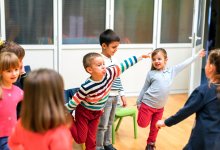Social & Emotional Learning (SEL)
Find resources to help students manage their emotions, resolve conflicts, and make responsible decisions—creating the healthiest school culture possible.
13 Ways to Celebrate Students’ Small Wins and Build Motivation
In pursuit of big gains, students’ smaller successes can go unnoticed. Research suggests that’s a missed opportunity to spark motivation.How to Address School Avoidance
To help reduce chronic absenteeism, schools can help students learn how to self-regulate and manage feelings of discomfort.Your content has been saved!
Go to My Saved Content.Using Theater Games to Build Students’ Working Memory
By holding onto the information necessary to play certain games, students develop skills that lead to academic success.Your content has been saved!
Go to My Saved Content.Teaching Young Learners Self-Calming Skills
To help early elementary students manage big emotions, try breathing exercises and sharing how you deal with overpowering feelings.Your content has been saved!
Go to My Saved Content.Improv in the Classroom
A collection of our popular articles and videos about how theater games and improvisation can spark creativity, build relationships, and boost academics and executive function skills alike.5.4kYour content has been saved!
Go to My Saved Content.Why Ages 2-7 Matter So Much for Brain Development
Rich experiences—from play to the arts and relationships—fundamentally shape a young child’s development.124.1kYour content has been saved!
Go to My Saved Content.3 Ways to Help Students Build Attention Stamina
These simple tools and strategies can improve focus in the classroom.Using Community Circles to Boost School Culture
Consistent large-group gatherings can help students learn how to build strong relationships with their peers and teachers.117Your content has been saved!
Go to My Saved Content.Making Students Feel Safe
A trauma-informed approach ensures that students feel safe, supported, and nurtured—to improve their chances of academic success.129.7kYour content has been saved!
Go to My Saved Content.When Students Are Traumatized, Teachers Are Too
Trauma in students’ lives takes an emotional and physical toll on teachers as well. Experts weigh in on the best ways to cope.113.7kYour content has been saved!
Go to My Saved Content.Building Classroom Community Through Daily Dedications
When students share stories about those who have inspired and impacted them, the whole classroom feels more connected.48.8kYour content has been saved!
Go to My Saved Content.The Science of Student Motivation
Noted author and psychologist David Yeager on the common mistakes we make when giving feedback to students, and how to tap into purpose and belonging to make classroom work more meaningful.8 Proactive Classroom Management Tips
New teachers—and experienced ones too—can find ideas here on how to stop disruptive behavior before it begins.78.2kYour content has been saved!
Go to My Saved Content.A Daily Support System for Students
Students who need extra social and emotional support have a quick check-in with an adult at the start and end of each day.89.9kYour content has been saved!
Go to My Saved Content.19 Ways to Help Elementary Students Self-Regulate
These strategies can help young learners practice an essential life skill—and foster classroom harmony in the process.











